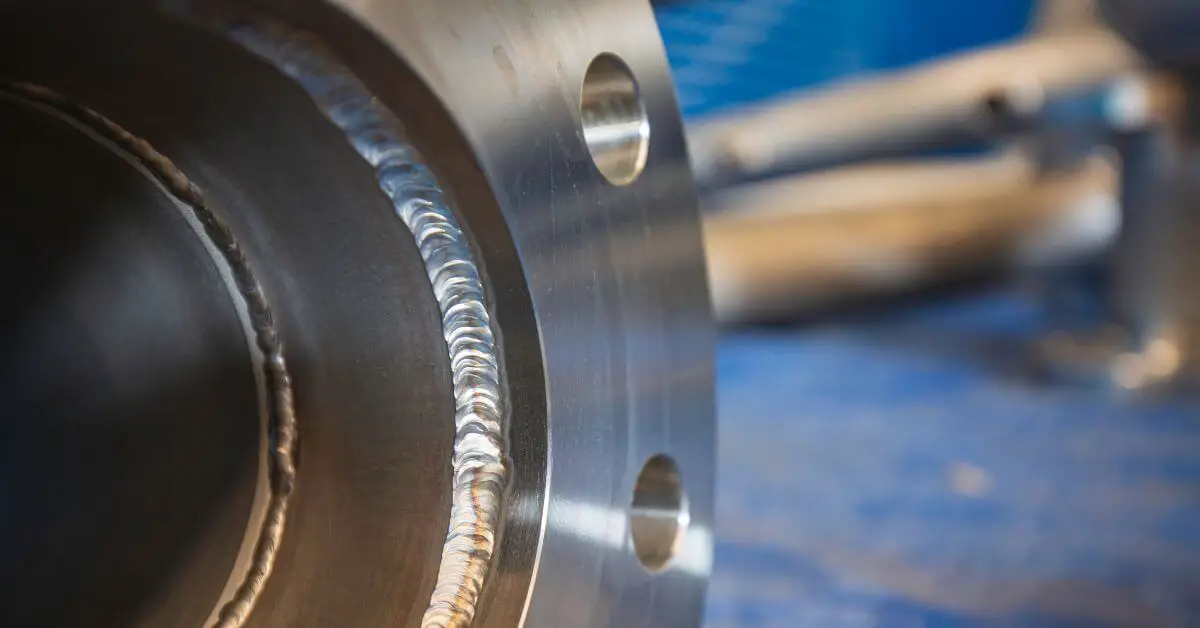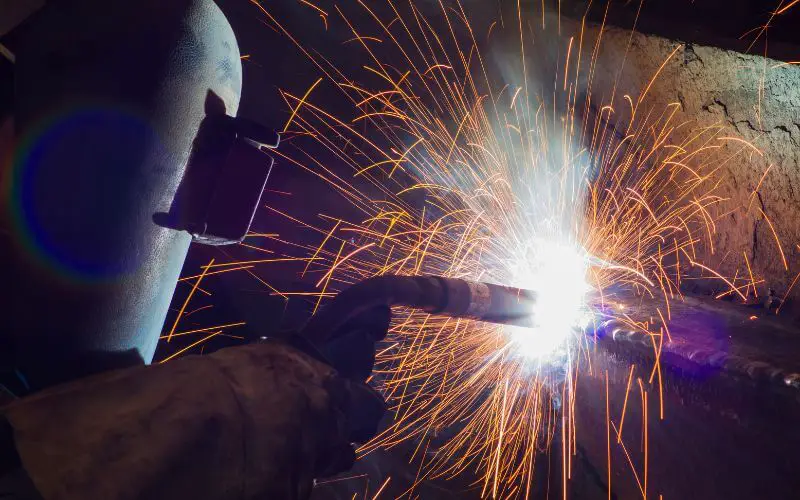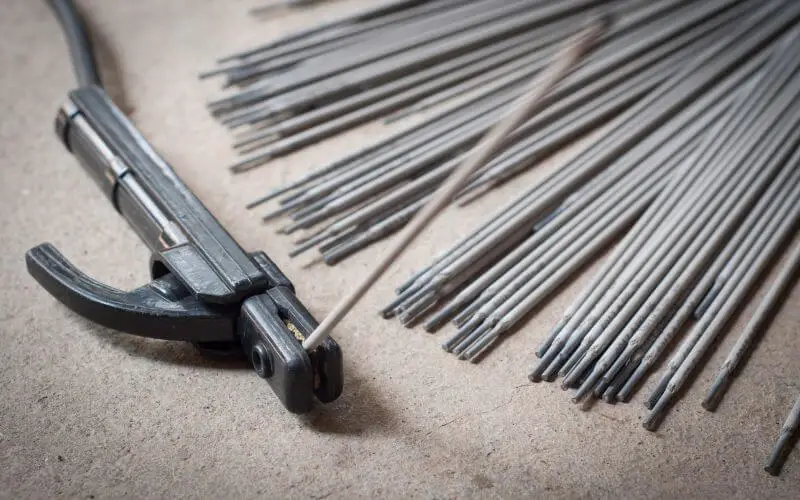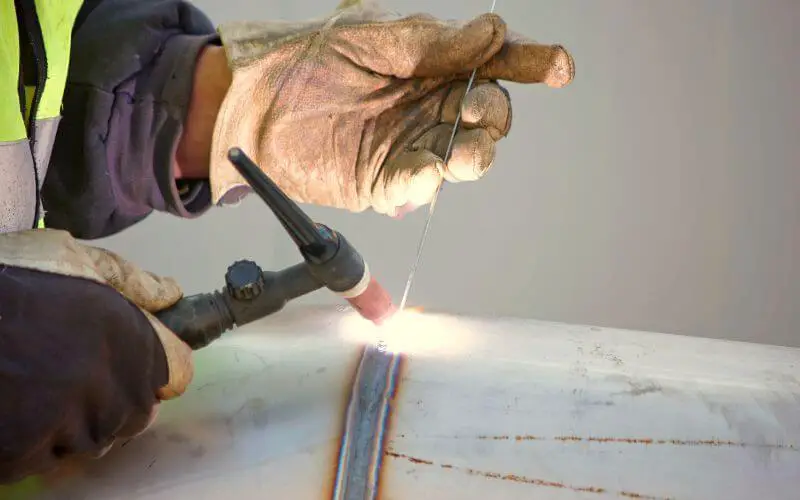Welding dissimilar metals like stainless steel to mild steel always challenges even experienced welders. However, a welder needs to know about the welding of dissimilar metals and practice it since it finds application in many industries, such as, chemical, oil, and gas, machinery, welding of stainless steel parts like catalytic convertors to carbon steel automobile exhaust, etc.
This article discusses how to weld stainless steel to mild steel in detail.
Brief about Welding Dissimilar Metals
Dissimilar metal welding means welding two base metals whose chemical composition, physical properties (melting point, thermal conductivity, etc.), and microstructure are completely different. An example is welding stainless steel to mild steel.
Welding dissimilar metals together is common in the equipment used in chemical plants, food processing plants, dairy machinery, the oil and gas industry, etc.
Factors to consider when Welding Dissimilar Metals
Melting Temperature
If the melting temperatures of the two dissimilar base metals to be welded vary by a wide range, the amount of weld pool produced will be small, and there may not be a good fusion between the weld metal and the two base metals.
Coefficients of Expansion
The varying thermal expansion rate in the two base metals can create undue development of internal thermal stresses. This may also lead to warping.
Coefficients of Thermal Conductivity
Suppose one base metal has a higher thermal conductivity than the other. In that case, the base metal with high thermal conductivity loses its temperature fast, and the joint properties may not be uniform all over the weld joint.
How to Carry out Stainless to Mild Steel Welding
GMAW or MIG welding, GTAW or TIG welding, and SMAW or stick welding are normally used to weld stainless steel to mild steel. Let us discuss this in detail.
The first step for stainless to mild steel welding is to understand the base materials being welded together, the selection of filler wire/electrode, surface preparation, and edge preparation. Stainless steel can be welded using one of the three welding processes (GMAW, GTAW, or SMAW).
Understand the Base Metals
The first step in understanding how to weld stainless steel to mild steel is understanding the difference between these two metals. Mild steel is an alloy of iron and carbon with an added layer of protection from corrosion due to its high chromium content.
The major difference is that stainless steel contains chromium, while mild steel has carbon as its alloy element. And stainless steel is four to five times more expensive than mild steel. One of the reasons you generally want to use stainless steel is its strong corrosion resistance.
Stainless steel effectively retains heat, causing it to warp when exposed to the high temperatures that welding creates. Stainless steel can also warp or crack during the cooling process after a welder has heated it. Even when a piece of stainless steel doesn’t crack or warp after a bad welding session, it will nearly always show scratches and blemishes.
The word stainless steel is a generic term; broadly speaking, stainless steel can be categorized into three types/grades based on its chemical composition and crystal structure. The three basic grades of stainless steel are austenitic, ferritic, and martensitic stainless steel, these crystal structures influence the mechanical and corrosion resistance properties.
Austenitic stainless steel is the most popular stainless steel grade used in the engineering industry due to its strength, weldability, formability, and excellent corrosion resistance.
AISI 304 is a highly used austenitic grade stainless steel, and its chemical composition is:
| AISI 304 Stainless Steel | ||||||
| Carbon | Chromium | Nickel | Manganese | Silicon | Phosphorous | Sulfur |
| 0.08% max | 18 to 20% | 8 to 10.5% | 2% max | 1% max | 0.045% max | 0.03% max |
Note: We are considering welding austenitic stainless steel grade AISI 304 to mild steel for discussion in this article.
| Chemical composition of mild steel | ||||
| Carbon* | Silicon | Manganese | Sulfur | Phosphorous |
| 0.16 to 0.18% | 0.4% max | 0.7 to 0.9% | 0.04% max | 0.04% max |
* Carbon percentage can be up to 0.3% in some cases.
The melting temperature of stainless steel AISI 304 is 1400° C to 1450°C (2552° F to 2642° F), and that of mild steel is 1350° C to 1530°C/2462° F to 2786° F (the exact temperature depends on the carbon percentage). Stainless steel has a low thermal conductivity compared to mild steel and undergoes work hardening.
Stainless steel grade AISI 304 is nonmagnetic in its annealed condition, and many people suggest using a magnet to confirm whether the base metal is stainless steel or not. This is a fairly good method, but it may only sometimes work. The reason is that AISI 304 undergoes work hardening (during flow forming, drawing, and similar processes), and work hardening may make it a bit martensitic.
AISI 304 in work-hardened condition becomes slightly magnetic. The work-hardening can be removed by annealing. The proper method of confirming whether the base metal is stainless steel is by checking its chemical composition. Welding stainless steel challenges inexperienced welders as it retains heat efficiently.
Selection of the Filler Wire and Electrode
When welding these two metals, you must select a filler wire whose chemical composition suits the superior of the two metals (it is stainless steel in our case). The selected filler wire or electrode should be high in alloy elements to prevent martensite formation (when diluted with mild steel) and retain small amounts of ferrite to counteract hot cracking during welding.
ER309 is the recommended grade of filler wire for TIG welding mild steel to stainless steel. ER309 has good mechanical properties and contains 5 to 10% ferrite. The recommended shielding gas is 100% argon.
ER309 L is the recommended MIG wire for MIG welding stainless steel to carbon steel (including mild steel), and the recommended shielding gas is 98% argon + 2% oxygen. ER309 L has good mechanical properties and contains 5 to 10% ferrite. The chemical composition of ER309 L is the same as ER309 except for a reduction in carbon percentage.
ER 309-17 is the commonly used electrode for stick welding stainless steel to mild steel. This rod contains 5 to 10% ferrite. The carbon content in this electrode ensures weld metal deposit with ferrite content to minimize the possibility of inter-granular carbide precipitation (may help minimize hot cracking also). 3/32ʺ, 1/8ʺ, and 5/32ʺ sizes of this electrode are used, and the welding current can be DCEP or AC.
Note: Carbide precipitation (chromium and carbon forms chromium carbide) reduces the chromium content and affects the corrosion resistance of stainless steel; hence, it should be controlled.
| ER309 Filler Wire | ||||||||
| Carbon | Chromium | Nickel | Molybdenum | Manganese | Silicon | Phosphorous | Sulfur | Copper |
| 0.12% max | 23 to 25% | 12 to 14% | 0.75% max | 1 to 2.5% | 0.3 to 0.65% | 0.03% max | 0.03% max | 0.75% max |
| ER309 L Filler Wire | ||||||||
| 0.03% max | 23 to 25% | 12 to 14% | 0.75% max | 1 to 2.5% | 0.3 to 0.65% | 0.03% max | 0.03% max | 0.75% max |
|
E 309-17 Electrode |
||||||||
| Carbon | Chromium | Copper | Manganese | Molybdenum | Nickel | Phosphorous | Silicon | Sulfur |
| 0.04% max | 22 to 25% | 0.75% max | 0.5 to 2.5% | 0.75% max | 12 to 14% | 0.04%
max |
1% max | 0.03% max |
Surface Preparation
Before beginning the welding process, please remember to use a separate cleaning brush, sander disc, flap disc, or any other consumable for stainless steel during stainless steel welding. The reason is the brush or a sander disc used for mild steel and carbon steel will have particles of that metal, and using it for stainless steel will contaminate the stainless steel surface.
MIG and TIG welding needs perfectly clean welding surfaces. SMAW welding may tolerate little contaminants on the welding surface, but a clean welding surface helps to eliminate welding defects.
Mild steel can have rusting, scale, paint, zinc plating, and contaminants like oil, grease, and dirt on its surface. You can use an angular grinder and wire brush to clean the surface of mild steel before beginning welding.
Around the one-inch area in the welding zone should be cleaned. The impurities on the welding surface can make the weld bead defective and weak and affect the corrosion resistance property of stainless steel.
The stainless steel base metal normally does not have scales, but it may have dirt, oil, and contaminants on its surface, which need cleaning. You can use acetone or alcohol-based quick evaporating cleaner to wipe off oil, grease, and contaminants.
If the stainless steel base metal was cut by plasma cutting, its plasma cut edges may have oxides, and such edges are to be cleaned with an angular grinder (mounted with a flap wheel) and a stainless steel wire brush.
Edge or groove preparation
Prepare the edges of the base metals for welding, considering the base metal thickness and type of joint. The weld groove should be a perfect fit. Inspect the welding surfaces again and remove any scale or contamination to ensure a clean welding surface.
Preheating
Preheating is normally not required when you are welding an austenitic grade stainless steel to mild steel.
Get ready for welding
Wear your welding gear, including hand gloves, shoes, welding helmet, ear muffs, and other recommended safety gear. Select a well-ventilated area and set up the welding process (MIG, TIG, or SMAW).
The above steps are common for every welding process, whether you do the welding by MIG, TIG, or SMAW process. Let us discuss each welding process now.
How to MIG Weld Stainless Steel to Mild Steel
Gas metal arc welding (GMAW) or MIG (metal inert gas welding) is a good process for joining stainless steel to mild steel. A MIG welding machine creates the most solid, reliable welds with stainless steel.
To MIG weld stainless to mild steel, you need a shielding gas to shield the molten weld pool from atmospheric air and impurities. It is important to select the correct shielding gas to protect the corrosion resistance property of stainless steel.
As discussed in the previous paragraphs, the recommended filler wire is ER309 L, and the general recommended shielding gas is 98% argon/2% oxygen or 98% Argon/2% Carbon Dioxide (CO2).
Select the wire diameter recommended for the thickness of the base metals and set the voltage/amperage, speed of wire travel, rate of gas flow, and inductance to the recommended values. The heat generated by the filler wire should suit both stainless steel and mild steel.
If the mild steel melts first, it can contaminate the molten weld metal. If the two base metals do not melt at the joint, then there is no fusion between the weld metal and the base metal, and the joint becomes a brazed joint instead of a welded one.
The stainless steel filler metal requires a lower current to melt off than mild steel filler metal, so expect to utilize lower wire feed and welding speeds than you may be used to. Likewise, the weld pool will be more “sluggish” than when welding using mild steel filler metal, and penetration will be reduced.
This means that you may need to use a wider included/bevel angle, depending on the application, to ensure good root and sidewall fusion.
The MIG welder voltage/amperage should be sufficient to create a controllable molten weld puddle that fuses with the base metals and creates a good-looking flat weld bead. Keep the stick-out of the filler wire as stable (constant) as possible and follow the technique of pushing the torch to give better coverage of the shielding gas to the weld joint.
Select the method of weld metal transfer suiting the thickness of base metals (short-circuiting, spray transfer, or pulsed spray transfer). Tack welding the stainless steel to mild steel before finishing welding can help to prevent warping (increase the number of tacks when the base metals are thin).
The stainless steel metal, the filler wire, and the shielding gas are expensive. Hence, if you have yet to gain experience welding dissimilar metals, it may be worth doing a trial welding before the actual job.
How to TIG Weld Stainless Steel to Mild Steel
TIG welding uses a tungsten rod to strike the arc and a handheld filler wire to create the molten weld pool. TIG welding gives the welder more control over the welding process (compared to MIG and stick welding) and allows the welder to create stronger quality welds.
As discussed in the above paragraphs, ER 309 is the recommended filler wire for welding stainless steel to mild steel, and the shielding gas is 100% argon. The choice of the filler material is based on the chemical composition and strength of the joint and the compatibility of its melting point with the base metals.
Select the filler wire diameter based on the thickness of the base metals. Set the welding parameters like the recommended current type, gas pressure/flow, voltage, and current. Tack-weld the base metals sufficiently to prevent warping.
TIG welding machines can be the right option for thinner materials and welds requiring beauty and precision. Still, TIG is a tough weld unless you have the experience and the time to do it properly. An inexperienced TIG welder can leave unfortunate marks or blemishes on stainless steel.
SMAW or Stick Welding Mild Steel to Stainless Steel
As discussed in the previous paragraphs, E 309-17 is the recommended electrode for stick welding stainless steel to mild steel.
ER 309-17 welding rod is normally available in diameters 3/32ʺ, 1/8ʺ, 5/32ʺ, and 3/16ʺ and is an all-position electrode, and can be used with DCEP or AC. Select the welding electrode diameter corresponding to the base metal thickness and use the ampere range mentioned on the welding rod box as a guide to set the ampere.
After yo complete the welding job, clean the weld bead and the welding zone completely to remove slag, spatter, and any other welding remains. The cleaning should be thorough since it affects the corrosion resistance of stainless steel.
Tips for Welding Stainless Steel to Mild Steel
- The conduction of heat in stainless steel is much slower compared to mild steel resulting in the weld zone remaining hot for more time, and this, in combination with the higher expansion rate of stainless steel, can lead to warping. Also, overheating the stainless steel can also affect its properties since it can lose part of its austenitic structure.
- The excess heat in the weld zone can be removed by chill bars. Copper or aluminum chill bars clad with a thin nickel sheet can be used when the stainless steel base metal is 14 gauges (2 millimeters) or less thick to avoid warping. Nickel cladding eliminates the reaction between copper/aluminum and molten weld metal.
- Colorization of stainless steel can be an indication of overheating it.
- When dissimilar metals are welded together, the working angle of the electrode may be modified slightly to point the filler wire toward the stainless steel base metal. This can be practised on scrap metal to arrive at an advantageous working angle for the filler wire.
- Tack welding the stainless steel to mild steel before finish welding can help to prevent warping and increase the number of tacks when the base metals are thin.
- Do the MIG/TIG welding of stainless steel to mild steel in closed premises. However, if you are welding outdoors, set the gas flow rate recommended for outdoor MIG/TIG welding and place a protective screen to guard the shielding gas.
- Stringer bead is preferred for welding stainless steel to mild steel, enabling faster speed with low voltage (low heat input).
- Avoid multi-pass welding by proper joint preparation with tight fitting. If multi-pass welding is not avoidable, clean the previous weld pass and wait for it to cool down before starting the next pass.
- It is a good practice to create a buttering layer on the mild steel welding surface with E 309 or E309 L welding wire before welding it to stainless steel. The butter layer on mild steel can minimize the problems arising from welding dissimilar metals. We recommend using the buttering layer when multi-pass welding stainless steel to mild steel.
- Once the welding is completed, thoroughly clean the weld bead and the heat-affected zone to remove the spatter and any other contamination since corrosion can start from such points. A flap wheel or a scotch-Brite wheel can be used for doing this. Take care not to mix stainless and mild steel during this process.
Other welding processes that can be used for welding stainless steel and mild steel are flux-cored arc welding (FCAW), plasma welding, etc.
Conclusion
Welding dissimilar metals like stainless steel to mild steel is a good skill to learn for a welder. You can get solid, even welds using the correct filler metal and following the proper low-heat procedure. The low-heat procedure ensures you don’t over-weld both parts since stainless steel warps when exposed to heat.
Hope this article on how to weld stainless steel to mild steel has helped you learn this skill.








